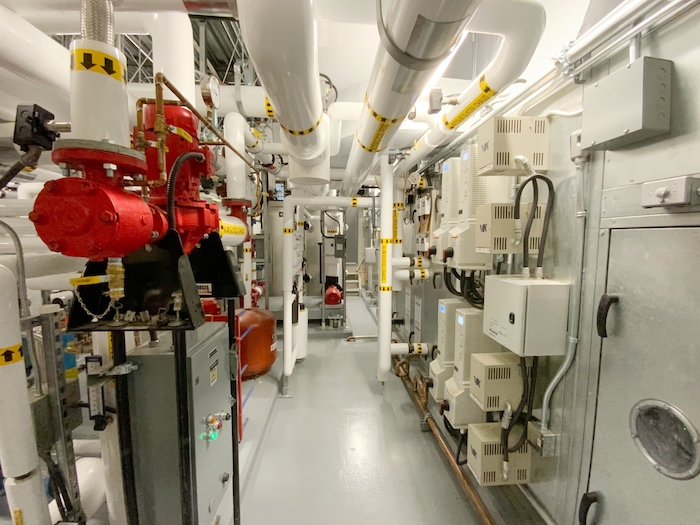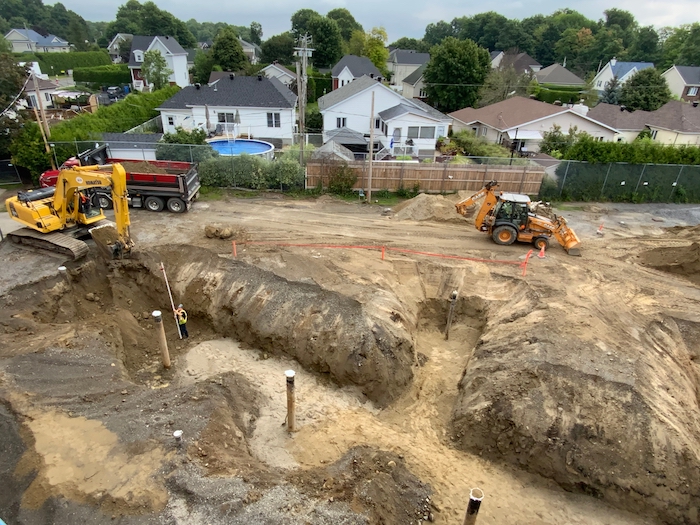
In-Depth
2023 #CCEAwards Showcase: Standing Column Wells for Clé-des-Champs School
October 24, 2023
By
Peter Saunders

Category: Natural Resources, Mining, Industry and Energy
Breton Environmental Award and Award of Excellence Winner: gbi
The Centre de Services Scolaire des Mille-Îles (CSSMI) mandated gbi to replace the heating, ventilation and air-conditioning (HVAC) system at the Clé-des-Champs primary school, which involved refitting its mechanical room. Through collaboration with the client, it was decided to install a geothermal heat exchanger with permanent column wells—a first for an institutional building in Québec—to make a major shift in energy consumption, reduce pressure on the local electricity generation and distribution network and combat greenhouse gas (GHG) emissions.
The concept is to heat and cool an indoor environment efficiently by directly using groundwater, which exchanges heat through conduction and advection with the hydrogeological environment. The technology can rely on a process called the ‘bleed,’ whereby undisturbed groundwater infiltrates a pumping well through a network of fractures in the rock.
A new concept
This technology has been the subject of research at Polytechnique Montreal, which worked with gbi to test its theoretical model and then demonstrate its viability for a real project.
The main advantage of permanent column wells is a significant reduction in the total number of wells that need to be constructed in the field, compared to a closed-loop well system.
With the use of closed-loop geothermal energy, 22 wells of 150 m in depth would have needed to be drilled at the Clé-des-Champs School. With the permanent column wells, on the other hand, only five pumping wells of 135 m in depth and one injection well were required, reducing the project cost by 40%.
Standing column wells are feasible in small spaces where geothermal energy was not previously considered an option, including the sites for many existing buildings that will need to be decarbonized in the years to come. Also, water resides longer in them and allows users to reduce their electrical power demand during severely cold winters.
Exploration with a deadline
One of the challenges was to respect an immutable deadline: the school calendar. The project began as soon as classes ended. The schoolyard had to be available to students, with its new wells, two months later.
Most of the work was condensed into short two-phase periods. Existing mechanical spaces were tight, so the team had to work creatively to optimize the available volume.
The project also stood out for its complexity at the level of the exploratory phase, since a lot of new information was needed to design the geothermal heat exchanger. In addition to a thermal response test, a pumping test and groundwater sampling were required.
The gbi team worked closely with Polytechnique to deploy an automatic control system capable of measuring and recording essential data for academic research activities. The use of groundwater raised several issues, such as the management of suspended solids, the risk of clogging and the durability of the facilities. The team responded to these challenges, among others, with the addition of a filtration system, a plate heat exchanger redundancy system to maintain continuous operation during maintenance and stainless steel components.

The team had to work creatively to optimize the available volume of the mechanical room. Photo courtesy gbi.
Just the beginning
One the island of Montreal, with its lack of available land, these wells offer a tangible option for existing commercial, residential or institutional buildings to benefit from geothermal energy.
Fewer wells mean less drilling time, which can reduce the initial investment cost compared to traditional geothermal energy. The reduced duration of work on-site allows teams to compress the schedule and to increase the number of projects achievable, which is important given drilling contractors are in high demand.
The team from gbi continues to work with the Polytechnique research chair. This collaboration not only makes it possible to advance knowledge, but it also helps inspire confidence in customers, who see the benefits of the technology through the success of the project at Clé-des-Champs School. Indeed, many have responded to the call to test permanent column wells in their own projects.
This innovation also makes it possible to extend the life of equipment and systems. With the geothermal heat pump’s stable operating conditions, due to the thermal inertia of the ground at great depth, its lifespan is estimated at 25 years compared to, for example, 15 years for aerothermal. This makes it possible to act on the problem of managing end-of-life refrigerants, which too often have a high global warming potential (GWP).
Standing column wells for geothermal energy also respond to a call from Hydro-Québec to reduce demand for electrical power during peak periods. As buildings represent 35% of all energy consumption across Quebec, decarbonization and energy efficiency can make a significant difference. The goal is to reconcile the paradox between the decarbonization of buildings and the management of electrical power demand on the network.
Satisfaction with self-sufficiency
Since the project’s launch, CSSMI has been more than satisfied with the technology, the team’s quality of service and the results—and also happy to contribute to this advance for the future. Ultimately, the objective is to make buildings self-sufficient.
“Despite the innovative nature of this file, I always felt gbi was well in control,” says Guillaume Marchand, project co-ordinator for CSSMI. “Throughout the project, I greatly appreciated the teamwork with various stakeholders. It is a source of pride to be a partner in the use of standing column wells, help develop this technology and demonstrate its efficiency under real conditions. Our school service centre uses geothermal systems as the main source of heating in approximately 15% of our parc-écoles. This type of system will improve the air quality inside the buildings, while reducing the energy bill by around 35% compared to conventional mechanical systems. This technology will undoubtedly contribute to fulfilling our primary mission of educational success.”
Standing Column Wells for Clé-des-Champs School, Mirabel, Que.
Award-winning firm (mechanical and electrical engineering): gbi, Montreal, Que. (Olivier Paquette-St-Jean, ing.; Jean-Michel St-Georges, ing.; Jasmin Faucher, CPI; Maxime Boisclair, ing.; Guillaume Gigoux-Théorêt, ing., M. Ing.; Eric Lemieux, Tech.).
Owner: Centre de Services Scolaire des Mille-Îles (CSSMI).
Other key players: Polytechnique Montréal (concept development), Lachance et associés architects (architecture), Construction Genfor (general contractor), Groupe Charbonneau (plumbing and heating contractor), Regulvar (automatic control contractor), Les forages LBM (drilling contractor), Multistack (water and heat pump), Franklin Electric (submersible pumps), Armstrong (heat exchanger and pumps), Delta Controls, Belimo, Siemens, Versaprofiles (piping), Bollfilter (filter).
Print this page
